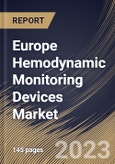Due to hypovolemia, cardiac dysfunction, or changes in vasomotor function, critically ill patients often experience hemodynamic instability (or are at risk of developing instability), resulting in organ dysfunction, multi-organ failure, and eventually death. With hemodynamic monitoring, the patient's outcomes can be increased by giving medical care and preventing or treating organ failure. Examples of therapeutic measures include vasopressors, inotropic drugs, and fluid resuscitation. Hemodynamic monitoring can be used to direct the resuscitation and de-resuscitation stages. This monitoring itself uses several techniques, and each has advantages and disadvantages of its own. These procedures can be invasive, less invasive, or even non-invasive and can be calibrated or uncalibrated.
Moreover, it is expected that the increase in the elderly population will result in several chronic health concerns, such as obesity, diabetes, and high blood pressure, which are the leading causes of cardiovascular diseases. Many home care settings offer monitoring services for the elderly population. As a result, the need for hemodynamic monitoring systems in these environments is expected to increase, further supporting market expansion throughout the projection period.
In Europe, the fatality rates from respiratory diseases are among the highest in the United Kingdom. Compared to other illness categories like cancer and cardiovascular disease, the health outcomes for respiratory diseases have not significantly improved during the past ten years. Based on findings from earlier studies, it can be estimated that at least as many patients have heart failure than are officially diagnosed. Those affected could live longer and have a far higher quality of life if found and treated in time because heart failure is remarkably treatable the earlier it is discovered. Therefore, the increasing cases of cardiovascular and respiratory diseases in the region will boost the demand in the hemodynamic monitoring devices market.
The Germany market dominated the Europe Hemodynamic Monitoring Devices Market by Country in 2022 and would continue to be a dominant market till 2030; thereby, achieving a market value of $128.4 Million by 2030. The UK market is estimated to witness a CAGR of 4.3% during (2023 - 2030). Additionally, The France market would showcase a CAGR of 6% during (2023 - 2030).
Based on Product, the market is segmented into Monitors and Disposables. Based on System Type, the market is segmented into Non-Invasive, Minimally Invasive and Invasive. Based on End Use, the market is segmented into Hospitals, Catheterization Labs, and Others. Based on countries, the market is segmented into Germany, UK, France, Russia, Spain, Italy, and Rest of Europe.
The market research report covers the analysis of key stakeholders of the market. Key companies profiled in the report include Edwards Lifesciences Corporation, GE HealthCare Technologies, Inc., Baxter International, Inc., ICU Medical, Inc., Masimo Corporation, Deltex Medical Group Plc., Sramek BioDynamics, Inc., Osypka Medical GmbH, Medtronic PLC, and Koninklijke Philips N.V.
Scope of the Study
Market Segments Covered in the Report:
By Product (Volume, Thousand Units, USD Million, 2019-2030)- Monitors
- Disposables
- Non-Invasive
- Minimally Invasive
- Invasive
- Hospitals
- Catheterization Labs
- Others
- Germany
- UK
- France
- Russia
- Spain
- Italy
- Rest of Europe
Key Market Players
List of Companies Profiled in the Report:
- Edwards Lifesciences Corporation
- GE HealthCare Technologies, Inc.
- Baxter International, Inc.
- ICU Medical, Inc.
- Masimo Corporation
- Deltex Medical Group Plc.
- Sramek BioDynamics, Inc.
- Osypka Medical GmbH
- Medtronic PLC
- Koninklijke Philips N.V.
Unique Offerings
- Exhaustive coverage
- The highest number of Market tables and figures
- Subscription-based model available
- Guaranteed best price
- Assured post sales research support with 10% customization free
Table of Contents
Companies Mentioned
- Edwards Lifesciences Corporation
- GE HealthCare Technologies, Inc.
- Baxter International, Inc.
- ICU Medical, Inc.
- Masimo Corporation
- Deltex Medical Group Plc.
- Sramek BioDynamics, Inc.
- Osypka Medical GmbH
- Medtronic PLC
- Koninklijke Philips N.V.








